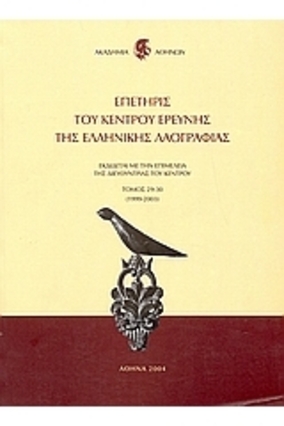Δένδρα ίερά-στοιχειωμένα στίς λαϊκές παραδόσεις : Ή σχέση τών παραδόσεων μέ βυζαντινές θρησκευτικές διηγήσεις καί μέ αρχαίους μύθους
Part of : Επετηρίς του Κέντρου Ερεύνης της Ελληνικής Λαογραφίας ; Vol.28, 1986, pages 69-108
Issue:
Pages:
69-108
Parallel Title:
Sacred haunted très inFoIk-tales and their relation to byzantine religions narratives and ancied myths
Author:
Abstract:
The author cites a number of contemporary folk-tales of sacred haunted trees which he examins through the centuries in relation to narratives that are found in religious texts in ancient myths. Contemporary folk-tales are either religious or superstitious. It is characteristic that in the religious tales the age-long trees, especially those near churches, are very majestic. They are regarded as sacred and are protected by a religious fear which prevents them from being cut dawn or destroyed. Whevener an attempt was made, the sacrilegious person was severely punished. These tales are reminiscent of the byzantine «Geoponika» (10th c.) where a vague reference is found of a prohibition preventing any action that could cause damage to sacred trees. The religious fear, according to the author, comes afterwards. It is the superstitious fear that has become the basis for the creation of the traditional tales. This fear derives from the belief that the age-long majestic trees are haunted and any person who roots them out or chops them down is punished by the ghost that dwells in them. One comes across such incidents in the religious texts, as in the lives of St. Hypatious (4th-5th c.) and St. Nicholas of Sion. The latter is associated to the life of St. Nicholas, episcope of Myron in Lycia, Asia Minor (4th a). Corresponding to the above folk belief is the representation of this myth on coins from Myron as well as on other ones that were found in Aphrodisias of Karia, Asia Minor. This myth is also mentioned in religious narratives of saints from the occident, namely Sulpicius Sevirus and St. Bonifatius. Characteristic ancient myths with which the author compares the greek contemporary folk-tales are the following: 1) The myth of the Helios or Seilos, the mythical ancestor of the Helloi or Selloi and founder of the oracle of Dodoni in Epirus, 2) The myth of Eresichthon, 3) The myth of Halirrothius, 4) The myth of Paraebius, which is mentioned by Apollonius of Rhodes, as well as other myths which as a hint are referred to in an epigram in Theocritus and elsewhere perhaps. Among the contemprary folk-tales, the byzantine narratives and the ancient myths, the author points out obvious similarities and correspondences which prove that the journey through the centuries is continuous and unbreakable. Finally the author points out that not only the chopping down of trees drives the ghosts dwelling in them to act in revenge, but also the opposite action, namely to prevent them from falling down and getting destroyed causes the beneficial action of the ghosts, as is derived by Apollonius of Rhodes in his comments of Argonautica.
Subject:
Subject (LC):




